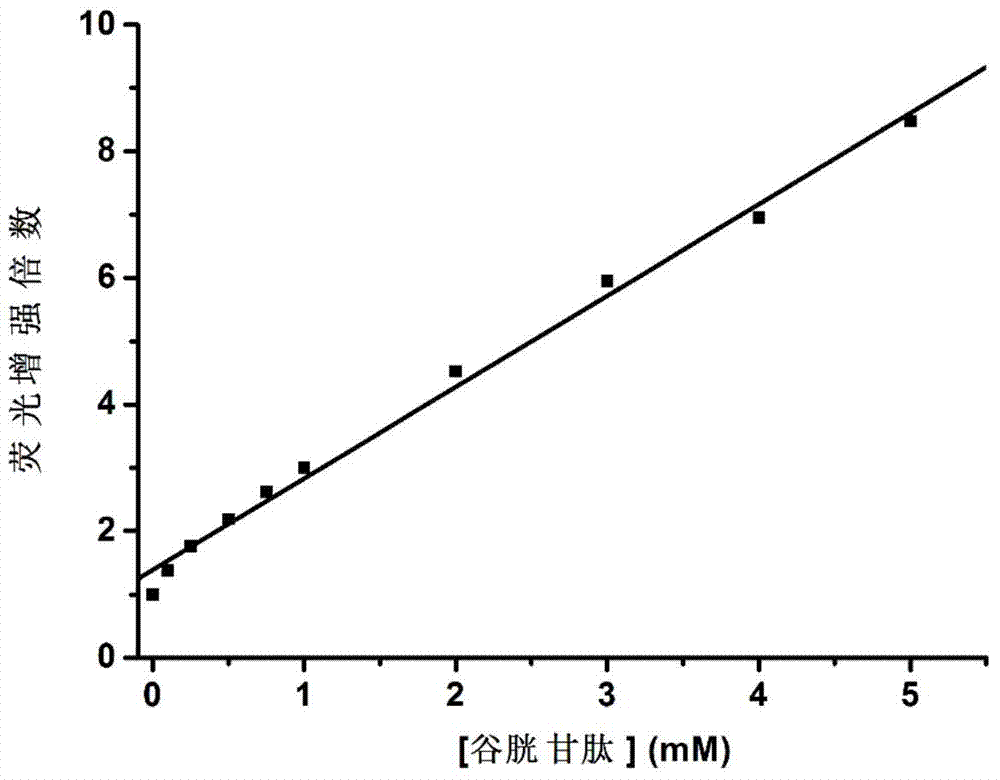Application of glutathione-based stable gold nano cluster particles to detection of sulfhydryl compound
A technology of sulfhydryl compounds and glutathione, which is applied in measuring devices, instruments, fluorescence/phosphorescence, etc., can solve the problems of small probe Stokes shift, serious photobleaching, fluorescence self-quenching, etc., and achieve specificity Good, short analysis time, significant specific effect
- Summary
- Abstract
- Description
- Claims
- Application Information
AI Technical Summary
Problems solved by technology
Method used
Image
Examples
Embodiment 1
[0021] Example 1 Preparation of glutathione-stabilized gold nanoclusters
[0022] At 25 °C, take 5 mL of chloroauric acid aqueous solution with a concentration of 1.0-10.0 mmol / L into a 15 mL plastic centrifuge tube, add 5 mL of 0.8-10.0 mmol / L glutathione aqueous solution to the chloroauric acid solution and Mix well to ensure that the mol ratio of chloroauric acid: glutathione is between 1:0.5 and 1:1. After 10-15 min, when the color of the mixture becomes colorless, adjust the pH value to 2-3. And put it in a 60~80 oC water bath for 1~2 hours to get a dark yellow transparent solution. Cool the solution to 25 °C, filter it with a 0.22 micron filter membrane, add the same volume of absolute ethanol to the filtrate, mix well, centrifuge at 10000 rpm for 10-20 minutes, weigh the sediment after drying, add 5-100 mmol / L phosphate buffer solution, ultrasonic (40 W, 40 KHz) for 2 min to dissolve the sediment in the phosphate buffer solution to obtain a gold nanocluster solut...
Embodiment 2
[0023] Example 2 Sulfhydryl compounds trigger fluorescence enhancement of gold nanoclusters
[0024] Take 0.5 mL of the glutathione-stabilized gold nanocluster solution prepared in Example 1, dilute it to 1.0 mL with deionized water, and record the excitation light of different wavelengths from 350 to 490 nm, and the wavelength range is 500 to 680 nm. Fluorescence Spectroscopy. Such as figure 2 The emission spectra of different wavelengths of excitation light of 350, 370, 390, 410, 430, 450, 470, and 490 nm are shown. Under the excitation light of 450 nm, glutathione-stabilized gold nanoparticles The cluster solution has the strongest fluorescence intensity, and its emission peak is located at 570 nm.
[0025] Take two 0.5 mL glutathione-stabilized gold nanocluster solutions, add 0.5 mL deionized water and glutathione aqueous solution of known concentration respectively, mix well for 15 minutes, and record in the wavelength range 350-490 nm Under the excitation light, th...
Embodiment 3
[0026] Example 3 Drawing of standard relationship curve between fluorescence enhancement factor and glutathione concentration
[0027] Take 0.5 mL of the above-mentioned glutathione-stabilized gold nanocluster solution and add 0.5 mL of glutathione with concentrations of 0, 0.1, 0.25, 0.5, 0.75, 1.0, 2.0, 3.0, 4.0, and 5.0 mmol / L respectively. Peptide aqueous solution, numbered 1~10 in sequence, after mixing for 15 minutes, record the fluorescence intensity of samples 1~10 at the emission wavelength of 570 nm under the excitation light with a wavelength of 450 nm. Calculate the ratio of the fluorescence intensity of samples 2 to 10 to sample 1, that is, the fluorescence enhancement factor F. With the glutathione concentration [thiol] as the abscissa and the fluorescence enhancement factor F as the ordinate, draw a linear standard curve, and use linear fitting to obtain the calibration relation: F= 1.39+ 1.44×[thiol] (mmol / L), the linear correlation coefficient of the fitti...
PUM
 Login to View More
Login to View More Abstract
Description
Claims
Application Information
 Login to View More
Login to View More - R&D
- Intellectual Property
- Life Sciences
- Materials
- Tech Scout
- Unparalleled Data Quality
- Higher Quality Content
- 60% Fewer Hallucinations
Browse by: Latest US Patents, China's latest patents, Technical Efficacy Thesaurus, Application Domain, Technology Topic, Popular Technical Reports.
© 2025 PatSnap. All rights reserved.Legal|Privacy policy|Modern Slavery Act Transparency Statement|Sitemap|About US| Contact US: help@patsnap.com



